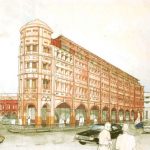
‘Organic’ is currently one of the favourite and frequently used catch words in the modern world. People talk about being ‘Organic’ relating it to many different fields for instance horticulture, fertilizer, clothing, food, products, computing, architecture, certification and so on.
But what really is ‘Organic’? As defined in scholar dictionaries, organic is ‘relating to or derived from living matter, denoting a harmonious relationship between the elements of whole – characterized by the natural development or being or coming from living plants and animals’.
By David Pearson | Reviewed by Archt Minushi Polhena
Undoubtedly most related to our readers is “organic architecture”. which came out as a philosophy of architecture during early nineties. The term “Organic Architecture” was invented by the great Architect, Frank Lloyd Wright (1867-1959). It can be explained simply as an architecture idea which promotes harmony between man-made structure and the nature around. The idea of organic architecture refers not only to the buildings’ literal relationship to the natural surroundings, but also on how the buildings’ design is carefully thought about as if it were a unified and interrelated organism.
“Wood should look like wood…”, “…a house should look part of the hill, not perched on it…” and “…don’t make a bank look like a Greek temple…” are some famous phrases in architecture which reflects approaches to organic architecture.
The intention of this write-up is not to present the reader with an essay on ‘Organic Architecture” but to update them about a great source of information which one can reach for, whenever they need to know a summarised compilation of almost all the information regarding Organic Architecture; the history and key concepts, sources and inspirations, about architects involved and their work related to organic architecture. This source is called “New Organic Architecture: The Breaking Wave, a book by David Pearson.
David Pearson is an architect-planner with degrees both from the University of London and the University of California, who has been actively involved in inner city and new community planning-both in Britain and the U.S. For more than ten years he has been active in the field of ecological design and works, lectures, and travels widely. He has for several years been with the Gaia movement which is inspired by the view of the Earth as a living planet, and a founder member of the Institute of Building Biology, England. He founded the Ecological Design Association and is the editor of Eco Design, the association’s journal. He is in touch with a network of “green” architects worldwide.
“New Organic Architecture: The Breaking Wave” strives to place organic architecture in a different standpoint, looking at the buildings in perspective of which both aesthetically pleasing and kinder to the environment. It includes an overview of basic principles followed by a gallery showcasing the work and ideas of leading organic architects, illuminating their key themes, sources of inspiration, the roots and concepts behind the style.
The first part of the book provides a history and assessment of organic architecture. And it revolves around eight key themes that define organic architecture: “Building as nature,” “Continuous present”, ”Form follows flow”, “Of the people”, “Of the hill”, “Of the materials”, “Youthful and unexpected” and “Living Music”. This section summarises the main principles of organic architecture and sets the movement in its historical context.
The second part offers a broad and comprehensive review of sources, and full-colour illustrations of built projects with statements by the architects, whose work is based on natural or curvilinear forms. It is indeed a beautifully illustrated portrayal of modern organic architecture, featuring thirty architects from all over the world.
It includes some popular passages like, “Clouds are not spheres, mountains are not cones, coastlines are not circles, and bark is not smooth, nor does lightning travel in a straight line…” and ‘Architecture is organic when the spatial arrangement of room, house and city is planned for human happiness, material, psychological and spiritual. The organic is based therefore on a social idea and not on a figurative idea. We can only call architecture organic when it aims at being human before it is humanist…” which have appeared
in previous books.
Filled with beautiful illustrations, New Organic Architecture explores forms inspired by nature and place. It is an inspirational book for a broad audience as it provides more complete and balanced picture of the increasingly influential trend towards organic design and environmental sustainability, with concise quotes and descriptions interweaving history, philosophy, design, and culture.
The flowing and inspirational prose, the abundant illustrations, and the admirably diverse selection of architects, make this book very informative and interesting and a valuable addition to one’s collection.

















